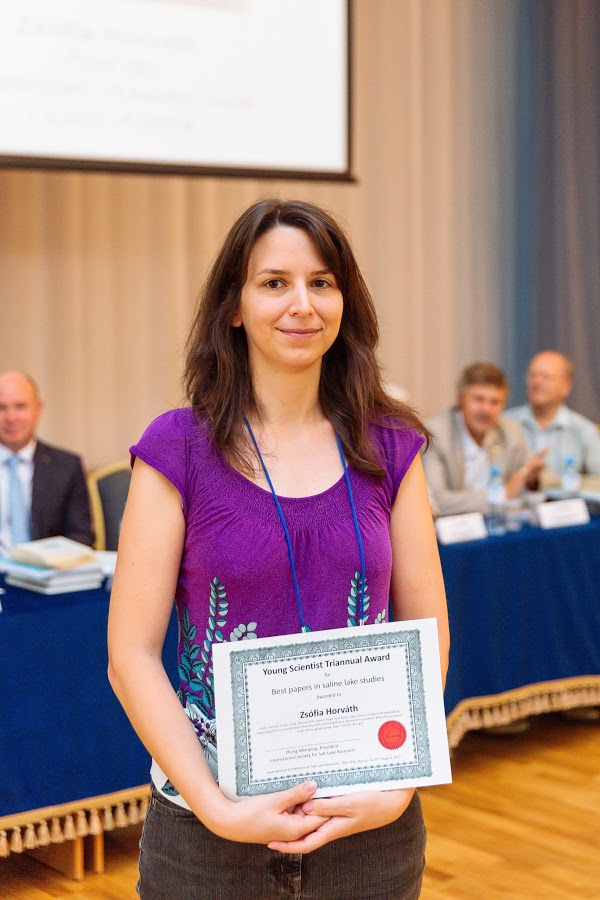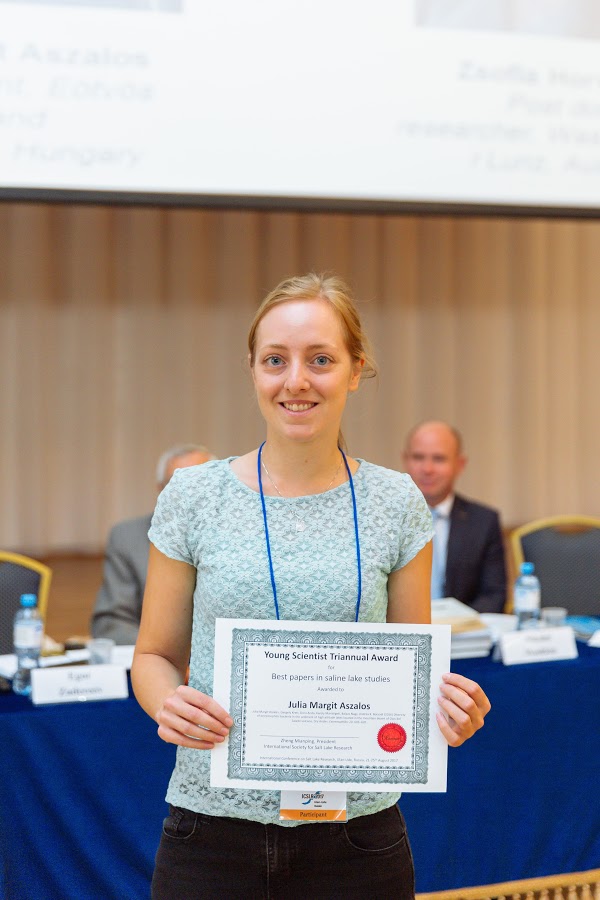Studies of Saline and Freshwater Lakes: In Search for a Common Ground
13th International Conference on Salt Lake Research (www.icslr2017.ru) was held during 21-25 August in the city of Ulan-Ude, Republic of Buryatia, Russia. About 120 scientists from 15 countries gathered there to discuss various studies focused on saline and freshwater lakes. This gave an impression about the nature of Trans-Baikal area and established contacts for future collaborative research.
The conference was organized by the International Society for Salt Lake Research (ISSLR) together with several research institutions from Siberia, namely the Institute of General and Experimental Biology (Ulan-Ude), Institute of Biophysics (Krasnoyarsk), Institute of Natural Resources, Ecology and Cryology (Chita), and Buryat State University. There were several specific topics that that were mentioned and discussed during the conference.
Extremophiles microbiology
Studies of unique microorganisms living in salt lakes are dominated by the number of papers in science of saline lakes. Many saline ecosystems are extreme habitats: in addition to high salinity, many of them experience strong solar radiation and low temperature (mountain lakes), high temperatures (thermal springs), anoxic conditions (meromictic lakes). Extremophiles are interesting, for example, from the point of view of searching for extraterrestrial life. Such organisms are also used to search for genes responsible for the resistance to extreme conditions, and to understand how life operates under extreme conditions. There are intensive studies on unique biogeochemistry of microorganisms living in extreme environments, the ability to couple cycles of different nutrients (e.g. sulphur, iron, nitrogen). Some species or isolated enzymatic systems can be used for various biotechnological applications, e.g. wastewater treatment.
The session devoted to extremophiles during the conference was most numerous. There were oral and poster talks on bacteria from high-altitude saline lakes in Chile, soda lakes of Transbaikalia, Hungary and Romania, the drying lakes of Australia and North America, and the deep waters of Lake Baikal.

Group photo of participants of 13 International Conference on Salt Lake Research, 21-25 August 2017, Ulan-Ude, Russia
In search for a common ground
The intensity of research studies on saline and freshwater lakes is not equal with much higher number of papers published on various aspects of freshwater science. However, the total volume of water stored in salt and freshwater lakes worldwide is almost comparable (Messager et al., 2016). Moreover, due to climate changes and various anthropogenic effects, division into saline and freshwater lakes is not always justified. It is more appropriate to consider a wide range of possible conditions (from fresh to salt waters) and to study how ecosystems are transformed when the concentration of salts increases.
The comparative plenary talk by Erik Jeppesen (Denmark) was focused on the reactions of saline and freshwater lakes to climate change. He discussed differences and similarities between them. Even reports on freshwater Lake Baikal were presented at the salt lakes conference. Now there is a slight decrease in the water level in Lake Baikal, most likely this is temporary phenomenon. However, for saline lakes this problem is typical. Saline lakes are closed basins. The water level in salt lakes depends on the amount of water inflow from the watershed and surface evaporation.
Recent analysis of the dynamics of the inland water areas in the last 32 years demonstrated that almost 70% of the changes are due to the shrinking, as for the Aral Sea (Pekel et al., 2016). This catastrophic decline in water volume in Aral Lake is mainly caused by the anthropogenic water diversions from inflowing rivers. Aral has not become a lesson for humanity. At the conference in Ulan-Ude there were several participants from Iran. They talked about the fate of Lake Urmia. This fate of this large lake with an area of several thousand square kilometers is similar to that of Aral Lake – it is drying up.
For freshwater lakes, the variability of water level and salinization become important because of climate change. For example, in the zone of the Mediterranean climate, there is a change in the ratio of the amount of water flowing in and evaporation losses from the territory (Jeppesen et al., 2015). As soon as excessive evaporation begins to concentrate salts, lakes become more saline. It is therefore important for the conference to discuss similar problems of the two research topics and to find common ground.
Young scientists support
Following the initiative of SIL, an international contest was announced before the conference for the best paper published by young scientists in 2014-2016 on the topic of saline lakes research. Winners of this competition received a diploma, a cash prize and an opportunity to make a plenary report.
There were two winners of the prize: Julia Margit Aszalos (Hungary) presented plenary talk “Diversity of extremophilic bacterial communities hosted by two high-altitude saline lakes located in the Puna de Atacama Plateau, Chile, and Zsofia Horvath (Austria) talked on “Biodiversity of zooplankton in European soda pans.”
Winners of the ISSLR Best paper award. Zsofia Horvath (Wasser Cluster Lunz, Ausria) and Julia Margit Aszalos (Eotvos Lorand University, Hungary)
Two prizes for young scientists for the best oral and best poster talk were also awarded at the conference. The main prize of the society is Bill Williams award that was given to Long Li (China) for the oral talk “Thermodynamic properties of lithium borates and their aqueous solution systems” and to the Elena Anufriieva (Russia) for the poster talk “Abundance and the ecological role of Eucypris mareotica (Crustacea, Ostracoda) in the Crimean hypersaline lakes”.
The other prize, Salinology award, was generously supported by the President of the ISSLR academician of the Chinese Academy of Geological Sciences, Zheng Mianping. Salinology awards were given to Ruy Santos (Belgium) for the oral talk “Halophilic bacteria and archaea as part of the Artemia diet” and to Veronika Dashkova (Kazakhstan) for poster talk “Assessment of phytoplankton community structure of Lake Balkhash using a FlowCam imaging flow cytometer”.
Other topics that were discussed at the conference included physical processes in saline lakes; geology and geochemistry of saline lakes; salt lake ecology and biology, food webs and biogeochemical cycling; paleolimnology; salt lake–landscape interactions, watershed studies; services provided by salt lakes: from chemical resources to cultural and social services and ecosystem modeling.
Two post-conference field trips were organized for conference participants to visit and have a glimpse of the Trans-Baikal area and local saline lakes and other unique ecosystems. This is a tradition of the meetings of the ISSLR, to make scientists familiar with local ecosystems of saline lakes, to expand knowledge and intensify research contacts.
For organizers, the work is not over yet. Selected articles after careful selection and peer-reviews will be published in special issues of the Chinese Journal of Oceanology and Limnology and the Journal of the Siberian Federal University. Biology. After, scientists on saline lakes will start preparations for the next forum. There are three applications to host next conference of the ISSLR in 2020 from Iran, Hungary and Spain, giving the board of directors of the society a difficult choice.
References
Jeppesen, E., Brucet, S., Naselli-Flores, L., Papastergiadou, E., Stefanidis, K., Noges, T., Noges, P., Attayde, J.L., Zohary, T., Coppens, J. and Bucak, T., 2015. Ecological impacts of global warming and water abstraction on lakes and reservoirs due to changes in water level and related changes in salinity. Hydrobiologia, 750(1), pp.201-227.
Messager, M.L., Lehner, B., Grill, G., Nedeva, I. and Schmitt, O., 2016. Estimating the volume and age of water stored in global lakes using a geo-statistical approach. Nature communications, 7, p.13603.
Pekel, J.F., Cottam, A., Gorelick, N. and Belward, A.S., 2016. High-resolution mapping of global surface water and its long-term changes. Nature, 540(7633), pp.418-422.
- Book of abstracts_13th International Conference on Salt Lake Research
- Scientific program_13th International Conference on Salt Lake Research
- Photo and video from the conference



